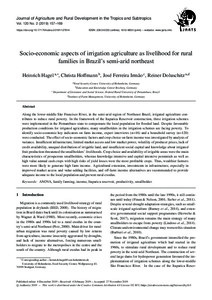Aufsatz

Socio-economic aspects of irrigation agriculture as livelihood for rural families in Brazil’s semi-arid northeast
Zusammenfassung
Along the lower-middle São Francisco River, in the semi-arid region of northeast Brazil, irrigated agriculture contributes to reduce rural poverty. In the framework of the Itaparica Reservoir construction, three irrigation schemes were implemented in the Pernambuco state to compensate the local population for flooded land. Despite favourable production conditions for irrigated agriculture, many smallholders in the irrigation schemes are facing poverty. To identify socio-economic key indicators on farm income, expert interviews (n=16) and a household survey (n=120) were conducted. The effect of socio-economic factors and crop choice on farm income was investigated by analysis of variance. Insufficient infrastructure, limited market access and low market power, volatility of producer prices, lack of credit availability, unequal distribution of irrigable land, and insufficient social capital and knowledge about irrigated fruit production threatened the smallholders’ livelihoods. Crop choice and availability of irrigable areas were the main characteristics of prosperous smallholders, whereas knowledge intensive and capital intensive perennials as well as high value annual cash crops with high risks of yield losses were the most profitable crops. Thus, wealthier farmers were more likely to generate high farm income. Agricultural extension, investments in infrastructure, especially in improved market access and value-adding facilities, and off-farm income alternatives are recommended to provide adequate income to the local population and prevent rural exodus.
Zitierform
In: Journal of Agriculture and Rural Development in the Tropics and Subtropics (JARTS) Vol. 120 / No. 2 (2019-12-04) , S. 157-169 ; ISSN 2363-6033Zusätzliche Informationen
Gedruckte Ausg. im Verlag Kassel Univ. Press (www.upress.uni-kassel.de) erschienen.Sammlung(en)
Vol 120, No 2 (2019) (Journal of Agriculture and Rural Development in the Tropics and Subtropics (JARTS))Zitieren
@article{doi:10.17170/kobra-20191127814,
author={Hagel, Heinrich and Hoffmann, Christa and Irmão, José Ferreira and Doluschitz, Reiner},
title={Socio-economic aspects of irrigation agriculture as livelihood for rural families in Brazil’s semi-arid northeast},
journal={Journal of Agriculture and Rural Development in the Tropics and Subtropics (JARTS)},
year={2019}
}
0500 Oax 0501 Text $btxt$2rdacontent 0502 Computermedien $bc$2rdacarrier 1100 2019$n2019 1500 1/eng 2050 ##0##http://hdl.handle.net/123456789/11378 3000 Hagel, Heinrich 3010 Hoffmann, Christa 3010 Irmão, José Ferreira 3010 Doluschitz, Reiner 4000 Socio-economic aspects of irrigation agriculture as livelihood for rural families in Brazil’s semi-arid northeast / Hagel, Heinrich 4030 4060 Online-Ressource 4085 ##0##=u http://nbn-resolving.de/http://hdl.handle.net/123456789/11378=x R 4204 \$dAufsatz 4170 7136 ##0##http://hdl.handle.net/123456789/11378
<resource xsi:schemaLocation="http://datacite.org/schema/kernel-2.2 http://schema.datacite.org/meta/kernel-2.2/metadata.xsd"> 2019-12-09T16:47:15Z 2019-12-09T16:47:15Z 2019-12-04 doi:10.17170/kobra-20191127814 http://hdl.handle.net/123456789/11378 Gedruckte Ausg. im Verlag Kassel Univ. Press (www.upress.uni-kassel.de) erschienen. eng Urheberrechtlich geschützt https://rightsstatements.org/page/InC/1.0/ ANOVA family farming income Itaparica reservoir productivity smallholder 630 Socio-economic aspects of irrigation agriculture as livelihood for rural families in Brazil’s semi-arid northeast Aufsatz Along the lower-middle São Francisco River, in the semi-arid region of northeast Brazil, irrigated agriculture contributes to reduce rural poverty. In the framework of the Itaparica Reservoir construction, three irrigation schemes were implemented in the Pernambuco state to compensate the local population for flooded land. Despite favourable production conditions for irrigated agriculture, many smallholders in the irrigation schemes are facing poverty. To identify socio-economic key indicators on farm income, expert interviews (n=16) and a household survey (n=120) were conducted. The effect of socio-economic factors and crop choice on farm income was investigated by analysis of variance. Insufficient infrastructure, limited market access and low market power, volatility of producer prices, lack of credit availability, unequal distribution of irrigable land, and insufficient social capital and knowledge about irrigated fruit production threatened the smallholders’ livelihoods. Crop choice and availability of irrigable areas were the main characteristics of prosperous smallholders, whereas knowledge intensive and capital intensive perennials as well as high value annual cash crops with high risks of yield losses were the most profitable crops. Thus, wealthier farmers were more likely to generate high farm income. Agricultural extension, investments in infrastructure, especially in improved market access and value-adding facilities, and off-farm income alternatives are recommended to provide adequate income to the local population and prevent rural exodus. open access Hagel, Heinrich Hoffmann, Christa Irmão, José Ferreira Doluschitz, Reiner publishedVersion ISSN 2363-6033 No. 2 Journal of Agriculture and Rural Development in the Tropics and Subtropics (JARTS) 157-169 Vol. 120 </resource>
Die folgenden Lizenzbestimmungen sind mit dieser Ressource verbunden:
Urheberrechtlich geschützt

